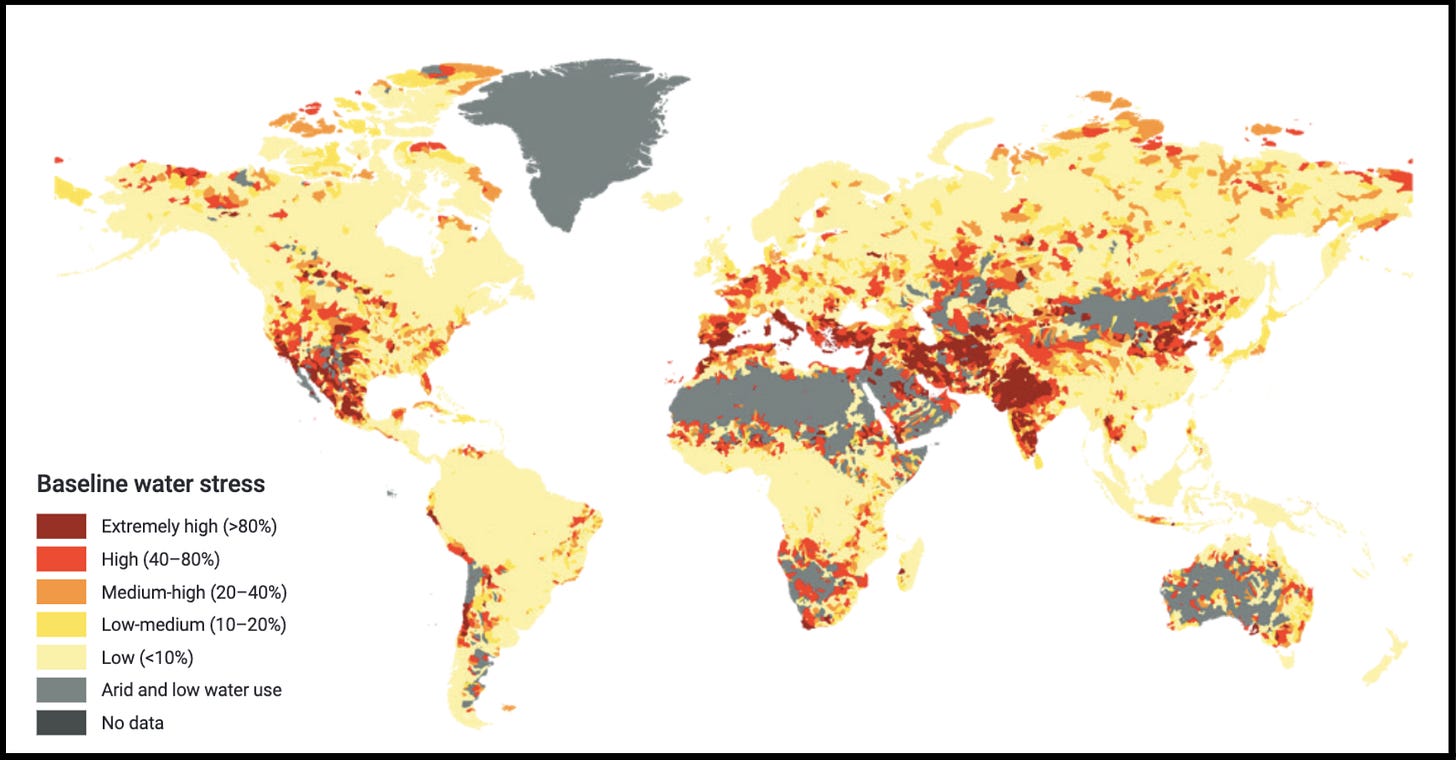Partnering with Vital Lyfe
The Ingredients of Life
One of our portfolio companies, Radiant Nuclear, recently shared their manifesto, and the opening paragraph struck a chord.
Humans are extraordinary — but simple — machines
We can survive and thrive in any environment on Earth or across the cosmos with an abundance of three basic ingredients—oxygen, water, and power. This is the triad of life support. Water and oxygen are pretty self-explanatory—both “why” they’re important, and “how” to get them—both here on Earth and beyond it. Power, on the other hand, has always been the challenge.
The triad of life.
We’re highly optimistic about the future of power, and fortunately we don’t have to think too much about oxygen. But as it turns out, that third leg of the stool actually needs a lot more support.
Water is life — and even with today’s technological marvels, we haven’t made enough progress delivering water to the entire world.
Where’s the Water?
Over 1.4 billion people deal with extreme levels of water scarcity. That’s over 15% of the world’s population. And more than 450 million of those people are children.
Access to safe, clean water remains a chronic and widespread challenge, especially in developing regions that lack robust infrastructure or face acute water scarcity. Nearly a quarter of the world lacks the infrastructure necessary to access water during a shortage, leading to water stress, often defined as the withdrawal-to-supply ratio.
In 5 years, demand for freshwater is expected to outpace supply by a staggering 40%, driven by population growth, urbanization, and climate.
This isn’t just an issue for developing countries. Google “water crisis in the U.S.” and you’ll see endless results: everything from wildfires in LA to poisoned water tables in Flint, Michigan. The U.S. Department of Defense spends billions annually on water-related logistics, including transporting and purifying water for military operations.
This is especially pernicious because when you look at our planet, it’s almost entirely covered with water. Yet despite our oceans’ abundance, we can’t drink it — and over 90% of the remaining freshwater is either trapped in glaciers or stuck underground.
So the natural question becomes, how do we solve that? How do we create clean water?
Hold the Salt
There are two ways to create more freshwater: Thermal Desalination uses heat, while Reverse Osmosis uses pressure:
Let’s start with Thermal. Thermal desal uses heat to boil water, and when the water evaporates, it leaves behind salt and other impurities. The water vapor is then condensed into freshwater. It’s a fairly simple process, and the main advantage is it can handle water with very high salinity levels (which reverse osmosis historically cannot handle). But the big problem is it requires a lot of energy to work.
Reverse osmosis (RO) is an entirely different approach. RO applies pressure into membranes (semipermeable materials with microscopic pores) that allow water to pass through, but hold back salt and other dissolved solids. In an overly reductive sense, RO basically pushes dirty water through a very strong paper towel — the paper towel captures all the impurities so only clean water can get through.1 The main advantage of reverse osmosis is its drastically lower energy consumption compared to thermal desalination.
RO is already widely used in desalination, wastewater treatment, and ultrapure water applications across a range of industries, including municipal water systems, pharmaceuticals, power generation, and food and beverage.
Yet today, desalination remains prohibitively expensive, highly energy-intensive, and frustratingly immobile — factors that limit its scalability and accessibility in the regions that need it most.
Today’s systems aren’t good enough to solve the world’s water problems. That’s why we’ve been searching for a team aiming to change that.
Vital Lyfe: Solving the World’s Water Problems
Vital Lyfe is tackling this problem in a very Cantos way: they’re building a decentralized, mobile, and affordable RO solution to solve our water crisis.
We love sharing the litany of reasons why companies we partner with offer better solutions than the incumbents. However, there are also times where speed and stealth are more valuable, so rather than spill all the secrets (and water) about what Vital Lyfe is up to, we’ll share a photo instead:
Vital Lyfe is cracking the code for scalable, decentralized desalination, and while we can’t provide full details of what they’re doing right now, we can share the how.
It all boils down to the team.
J Criss and Harner – The Master Builders
We first met Vital Lyfe’s founding duo last year. Jonathan Criss and Andrew Harner each had decade plus tenures at SpaceX, where they tackled some of the toughest engineering challenges of the last decade.
In many ways, this was a quintessential Cantos story. We had a ton of mutual overlap with them, but our original introduction came from a founder we had passed on more than 4 years ago.
We quickly began spending time with the team and helped them get off the ground. A few months later we were able to formally partner together and lead Vital Lyfe’s preseed round.
Most people would be quick to recount J Criss’ and Harner’s resumes. And rightfully so. J Criss served as Product Manager for Dragon and the Engineering Manager for Starlink — overseeing the creation of the first reusable spacecraft and delivering numerous Starlink products to markets all around the world.
Harner most recently was Mission Manager, directing operations for Starlink design and distribution, enhancing system readiness, and implementing automation to optimize hardware. Before that he managed the integration and functional testing of the full avionics system for both the Falcon 9 and Starship rockets as Lead Avionics Engineer.
We were quite excited about their leadership and unique manufacturing heritage. Very few people in the U.S. — and the world — have their skillset and track record.
But we were also excited because of who they are as people.
J Criss is a machine who happens to also be exceptional at making machines. He’s a gifted engineer, one that his former colleagues repeatedly raved to us about. This talent is paired with a general tenacity with which he attacks his goals, and the processes he creates to achieve them. Our early chats often drifted to daily routines and learning systems, and then bounced to jiu jitsu and training for the Olympics. As importantly, he’s a fantastic leader who sets the tone and knows how to get the most out of the people he works with.
Harner shares the same level of doggedness and devotion. He’s another great instance of a “Kool-Aid Man” as we like to say. Harner carries himself with a level of thoughtfulness and intentionality that steadies and guides the rest of the team. He’s deliberate with his time and energy, and is excellent at the core blocking and tackling required in the early days of any startup. He has a unique ability to quickly build trust and rapport with people, and he always finds ways to add levity to our discussions in a tasteful way.
Their level of respect and admiration for each other is evident, and together they make a special cofounding team. They understand what it takes to deliver hardware innovation at scale and under pressure.
The broader team amplifies this strength: Lawrence Lujan, Benjamin Parks, and Rachna Igwe join from places like SpaceX and Relativity Space, bringing extensive experience with aerospace-grade manufacturing, materials science, and government partnerships. Collectively, they form one of the most technically credible teams in water tech today.
Over the Top Infrastructure
The underlying insight behind Vital Lyfe came from the team’s time with Starlink. As they successfully rolled out Internet access to developing countries, they realized they were able to bypass much of the bureaucratic red tape that has historically frozen other broadband build-out initiatives.
Instead of waiting for capex heavy infrastructure to be built (and approved), they could just roll out infrastructure over the top, turn on a Starlink mini terminal, and immediately have Internet access.
As J Criss and Harner began thinking about all the other utilities that could benefit from this model, their minds naturally drifted to the biggest one of all — water.
As they dove deeper, they realized the over-the-top infrastructure play they helped pioneer would easily port over.
The key insight was simple: decentralization beats centralization. Massive, billion-dollar desalination plants have their place, but global freshwater scarcity demands flexible and decentralized solutions.
By designing modular, high-performing RO systems, the company delivers an immediate, practical solution for regions where building or upgrading traditional infrastructure is prohibitively slow or expensive. This approach bypasses many of the costly, time-consuming steps required to stand up large treatment facilities, enabling faster impact at lower cost.
We view this as a definitive Cantos preseed opportunity — two exceptionally well referenced engineers that are tackling a big market with a foundational key insight, and the same rapid hardware playbook we’ve seen many of our other portfolio companies successfully employ.
This is a group that has massive aspirations, and we believe in what they can accomplish. We’re thrilled to announce our partnership with J Criss, Harner, and the rest of the Vital Lyfe team. We’re also excited to be working with our friends at Space VC, Generational Partners, and Also Capital.
Water For People
Perhaps fittingly, in 5th grade my class was assigned a year-long project about a topic of our choosing. I chose water.
I researched organizations that were providing access to clean drinking water. I ended up doing a presentation on Water for People.2
Out of curiosity, I revisited Water for People’s website today to see how things have changed. The numbers are staggering: 2.2 billion people lack safe drinking water, 3.5 billion lack proper sanitation, and 2.3 billion can’t even wash their hands at home.
These numbers are worse than when I gave my original presentation. Even after all this time we still haven’t fixed the underlying issues — they’ve only gotten worse.
My 11-year-old self would have never expected that.
There’s a number of reasons why this has been the case. Entropy and incentives are powerful forces, and you need a lot of energy and willpower to change an underlying system.
That’s why this job is special. We get to partner with the people willing to roll up their sleeves and get to work. They dare to change the world, and our goal is to help them as they set sail to do that.
J Criss, Harner, and the team are aiming to do just that, and we couldn’t be more pleased to join them as they set out to make water scarcity a relic of the past.
Earth has no shortage of water, just a lack of accessible solutions. Vital Lyfe is building the tech to finally change that.
Now in reality it’s more complicated than that. The salty brine has a separate path out of the filter, and you need a stronger membrane if you’re dealing with saltier water.
In an ironic twist of fate, just after giving my presentation on the importance of water I put my mother’s laptop into her tote bag, unaware that there was a leaky water bottle inside. The laptop didn’t survive, and neither did my presentation.









